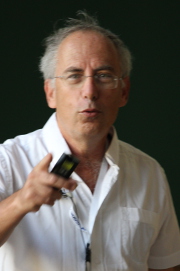Data: czwartek, 26.03.2015, godz. 15:30
Prelegent: prof. Gil Kalai
Tytuł: What can we learn from a failure of quantum computers
Abstrakt: Quantum computers are hypothetical devices that enable us to perform certain computations hundreds of magnitude of order faster than digital computers. This feature, coined “quantum supremacy”, could be manifested by experiments in the near future through, for example, BosonSampling, a very simple setting of non-interacting bosons. In the lecture I will give a brief background about computation - classic and quantum, with an emphasis on the role of determinants and permanents.
Next I will explain reasons to believe that computationally superior quantum computers cannot work, and what predictions on quantum physics and on computations of natural systems are supported by the failure of quantum computers.
Wideo
Program
| 26.03.2015 r. | |
| 09:30 | Złożenie kwiatów pod pomnikiem |
| 15:00 | Spotkanie w Klubie Profesorskim WMI |
| 15:30 | Gil Kalai What can we learn from a failure of quantum computers |
Prelegent
 Gil Kalai (ur. w 1955 r.) jest wybitnym profesorem nauk matematycznych najbardziej znanym ze swoich osiągnięć w informatyce teoretycznej. Studiował na Uniwersytecie Hebrajskim w Jerozolimie, gdzie obecnie zajmuje prestiżowe stanowisko the Henry and Manya Noskwith Chair. Jest równocześnie profesorem informatyki na Uniwersytecie Yale. Prowadził badania na wielu czołowych uniwersytetach i jednostkach badawczych Stanów Zjednoczonych, w tym: MIT, Cornell, IAS, KTH, Bell Laboratories, IBM i Microsoft. Gil Kalai jest także szeroko znany z prowadzenia blogu zatytułowanego Combinatorics and More, którego znaczenie dla środowiska naukowego trudno przecenić. Uzyskał wiele prestiżowych nagród, w szczególności: Pólya Prize (1992), Erdös Prize (1993), Fulkerson Prize (1994) oraz Rothschild Prize (2012).
Gil Kalai (ur. w 1955 r.) jest wybitnym profesorem nauk matematycznych najbardziej znanym ze swoich osiągnięć w informatyce teoretycznej. Studiował na Uniwersytecie Hebrajskim w Jerozolimie, gdzie obecnie zajmuje prestiżowe stanowisko the Henry and Manya Noskwith Chair. Jest równocześnie profesorem informatyki na Uniwersytecie Yale. Prowadził badania na wielu czołowych uniwersytetach i jednostkach badawczych Stanów Zjednoczonych, w tym: MIT, Cornell, IAS, KTH, Bell Laboratories, IBM i Microsoft. Gil Kalai jest także szeroko znany z prowadzenia blogu zatytułowanego Combinatorics and More, którego znaczenie dla środowiska naukowego trudno przecenić. Uzyskał wiele prestiżowych nagród, w szczególności: Pólya Prize (1992), Erdös Prize (1993), Fulkerson Prize (1994) oraz Rothschild Prize (2012).
Do najważniejszych i najbardziej znanych osiągnięć Gila Kalai należy klasyczna już praca, wspólna z Jeffem Kahnem i Nati Linialem, o funkcjach boolowskich, w której zastosowano aparat analizy Fouriera. Aparat ten został z powodzeniem wykorzystany przez Gila Kalai i współautorów w wielu innych ważnych zagadnieniach informatyki teoretycznej.
W 1993 roku Gil Kalai i Jeff Kahn konstruując pewien 1325 wymiarowy obiekt geometryczny obalili postawioną w 1933 roku znaną hipotezę Karola Borsuka.








